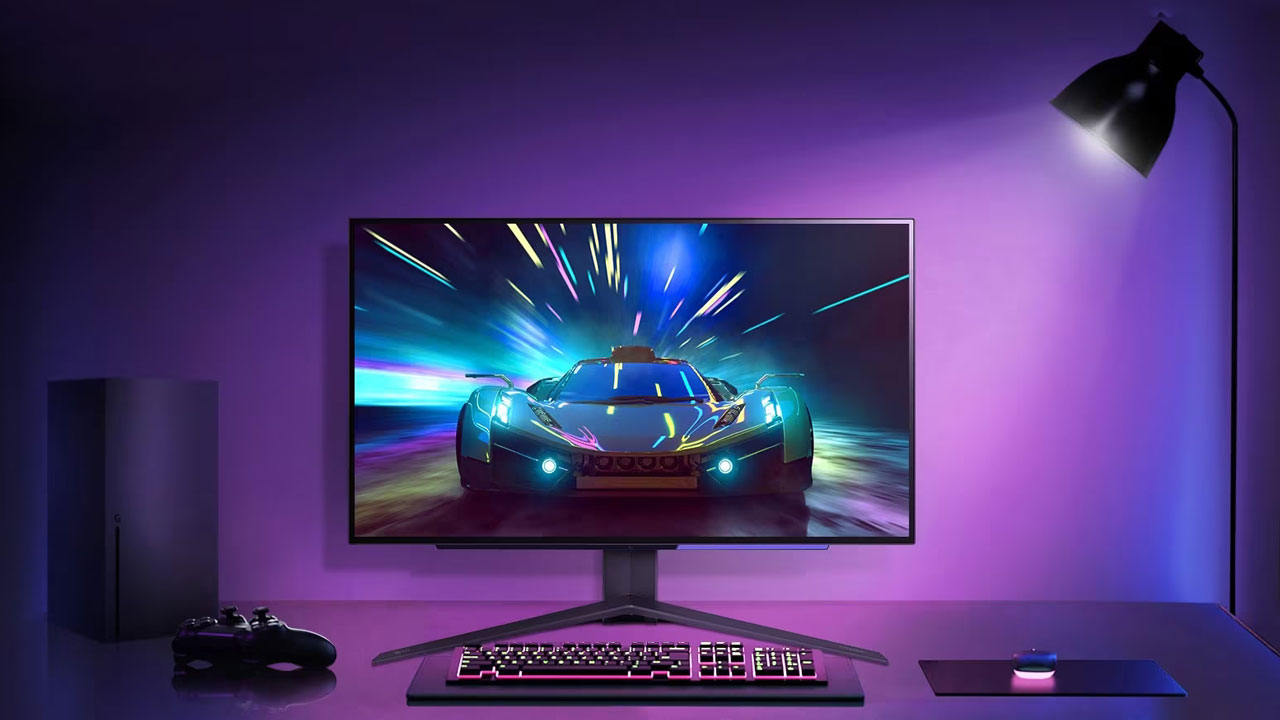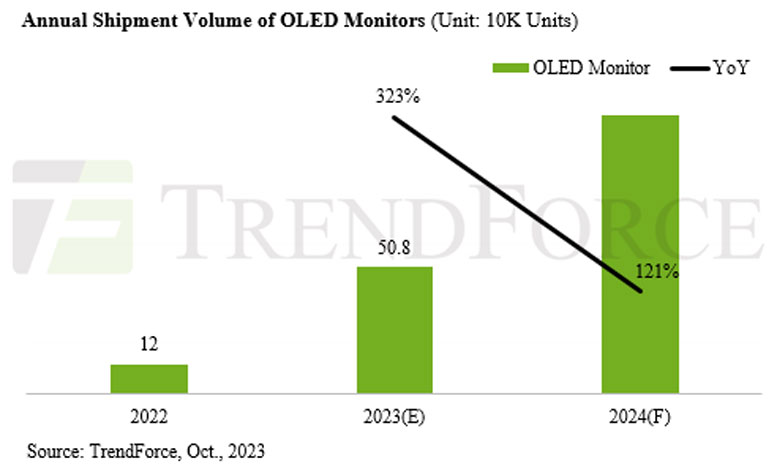OLED Monitor Shipments to Surge 323% This Year, Says Market Research Firm
And next year it expects there to be over 1 million OLED monitors sold.

This year, OLED monitors might finally achieve a comfortable foothold in the PC market. IT industry analysts at TrendForce see OLED monitor shipments rising 323% YoY by the end of 2023. The firm characterizes the current OLED monitor surge as “astronomical” and sees 2024 as another great year, with shipments doubling to one million units or beyond.
It is noted that Samsung is getting serious about its participation in the OLED monitor market in 2023. The source press release says that Samsung could potentially capture a market share of 27% in H2 2023, which would bring it up to a similar level as market leader LG.
Dell seems interested in establishing itself as a well-known OLED monitor brand and could clinch a 20% or better market share. Meanwhile, Asus and its sub-brands hold a 9% OLED monitor market share in 2023. Other OLED monitor suppliers like Acer, AOC, Philips, and Corsair account for the remaining 15% of the market.

More Shapes and Sizes Coming
In addition to the number of OLED monitor units shipped increasing rapidly, PC users will be pleased with a richer diversity of screen shapes and sizes, reckons TrendForce. The analyst firm sees 34-inch models as pioneering OLED adoption this year. It says 37% of all PC OLED monitors are based around panels with this diagonal size. The other two popular (and available) sizes in 2023 include 27-inch OLEDs (32% market shares) and 49-inch (14%). 45-inch OLED monitors aren’t as widespread, with just 10% market share.
Next year, both Samsung and LG are expected to make 31.5-inch OLED offerings much more commonplace. We might see these newly available panels grab over 10% market share in 2024, according to TrendForce.
TrendForce discusses monitor sizes and trends, but we hope there will be more variety in aspect ratios. Ultra- or super-wide rations are popular with panel makers and product designers, especially with curves. It would be better for choice if we could also see some squarer ratios and flat panel options.

OLED display panels have long had a reputation for image burn-in, but the big players have tweaked and changed tech to help minimize this undesirable screen image retention effect. To read more about such technologies, and their application by various TV makers, check out our recent report on OLED TV burn-in investigations by RTINGs. Also, as brands implement this kind of feature in different ways, even between ranges, check out third-party reviews of OLED monitors (and laptops with OLEDs) that you are interested in.
Get Tom's Hardware's best news and in-depth reviews, straight to your inbox.

Mark Tyson is a news editor at Tom's Hardware. He enjoys covering the full breadth of PC tech; from business and semiconductor design to products approaching the edge of reason.
-
Order 66 Unless OLED monitor prices come down significantly, I don't see how they will ever have a dominant market share, because most people can't afford a $700+ monitor, not to mention that people oftentimes will just use their existing OLED TV as their monitor.Reply -
helper800 Reply
OLED has, for years, been an order of magnitude better than LCD panels. The reason costs have been high and adoption has been low is because monitors with OLED panels have been far and few between until the last couple years. Low and behold when companies start designing and making OLED displays they suddenly get a ton of market share and interest. OLED TVs make for very good large monitors other than them not acting like a proper monitor when turning them on and off with the PC. If a good 34-42 inch 16:9 or 16:10 OLED ultrawide monitor that was NOT curved was available in 5160 x 1440 or 1600 resolution I would have it already. At the time I was looking for an OLED monitor I ended up with a LG CX OLED TV at 55" instead.Order 66 said:Unless OLED monitor prices come down significantly, I don't see how they will ever have a dominant market share, because most people can't afford a $700+ monitor, not to mention that people oftentimes will just use their existing OLED TV as their monitor.
I believe the market for OLED monitors is only going to grow larger and larger especially as costs come down. Even with costs as they are, as more models of OLED monitors are released, I would expect the market to continue exploding in size. -
rkmcquillen I understand the "Trend Analysis".Reply
OLED currently serves only the high end; with it being both Large(27" monitors) and pricey($700+).
To hit the mainstream, we would need some 22" monitors for about $300. Those don't exist, so I don't foresee the explosive growth continuing.
I would like to see what percentage of the high end market that OLED has already captured; I would think it's already over 50% on New(last 12 months) and Large/Expensive Monitors. -
helper800 Reply
Not even close to that yet.rkmcquillen said:I would like to see what percentage of the high end market that OLED has already captured; I would think it's already over 50% on New(last 12 months) and Large/Expensive Monitors. -
Alvar "Miles" Udell The sub $1000 price point many OLED monitors have, even the 48 inch models, it's not surprising to see them start to really gain in popularity. While using them only for gaming and watching videos (with a second, LCD monitor being used for other things) might essentially eliminate the burn in risk for years, using them as a static display will doom them, as happened to Toms Guide's UK editor.Reply
Personally I don't think OLEDs are worth the risk at this time, not unless you're a professional content creator and can business expense an OLED monitor, but even then there are numerous inexpensive IPS models with high (>120) refresh rates and 100% or greater AdobeRGB and DCI-P3 coverage, and for "gamers" there are numerous high (>240) refresh rate VA monitors that will last for years without worry.
https://www.tomsguide.com/opinion/i-didnt-fear-burn-in-on-my-oled-gaming-monitor-until-i-got-burned -
USAFRet Reply
There is a LARGE market outside of regular consumer space.Order 66 said:because most people can't afford....
Recently, I had occasion to spend time in a major hospital. Not for me, but with a family member.
On my desk, a 2 monitor stand.. a nice consumer level Ergotron. You can buy one...
In the hospital...Ergotron holding up everything. Monitors, etc.
Go for a CAT scan?
What is the logo on that multi million dollar piece of equipment?
Toshiba.
Imaging devices?
Olympus. -
helper800 Reply
Motion clarity in OLED panels is nearly perfect at 120-240hz wich they meet, meanwhile, 500hz tn panels look worse in comparison to OLEDs. I will take my 120hz LG CX over any 300hz or lower non-OLED panel for motion clarity, and frankly, everything else too.Alvar Miles Udell said:The sub $1000 price point many OLED monitors have, even the 48 inch models, it's not surprising to see them start to really gain in popularity. While using them only for gaming and watching videos (with a second, LCD monitor being used for other things) might essentially eliminate the burn in risk for years, using them as a static display will doom them, as happened to Toms Guide's UK editor.
Personally I don't think OLEDs are worth the risk at this time, not unless you're a professional content creator and can business expense an OLED monitor, but even then there are numerous inexpensive IPS models with high (>120) refresh rates and 100% or greater AdobeRGB and DCI-P3 coverage, and for "gamers" there are numerous high (>240) refresh rate VA monitors that will last for years without worry.
https://www.tomsguide.com/opinion/i-didnt-fear-burn-in-on-my-oled-gaming-monitor-until-i-got-burned -
hotaru.hino Reply
I don't know what monitor or panel you were looking at, if you were looking at one at all, but comparing https://www.testufo.com/ on my Odyssey Neo G8 against my cell phone with an OLED screen, they both look effectively the same at the highest frame rate. And both of them have a slight amount of perceived motion blur.helper800 said:Motion clarity in OLED panels is nearly perfect at 120-240hz wich they meet, meanwhile, 500hz tn panels look worse in comparison to OLEDs. I will take my 120hz LG CX over any 300hz or lower non-OLED panel for motion clarity, and frankly, everything else too.
There's an ugly truth with most panels now: all of them have some amount of perceived motion blur because your eyes like to blend sudden changes together. Sample and Hold is the problem here. The only way to get around this is to pulse the image (or at the very least, shorten the when the frame is visible throughout the refresh period). Though the problem is that most pulsing methods cut the screen brightness by a lot. -
helper800 Reply
What exact phone do you have? OLEDs have nearly instant response time. Scroll down to the part where they test response time. I am looking at my LG CX OLED at 120 HZ compared to my 165hz Viewsonic xg270qg at 165hz. The OLED looks multitudes better in a side by side. I have also done side by sides at Microcenter with OLEDs compared to other panels at over twice the framerate, the OLEDs look just as good at half the framerate. Don't take it from me, read this article from toms, and in particular the second page.hotaru.hino said:I don't know what monitor or panel you were looking at, if you were looking at one at all, but comparing https://www.testufo.com/ on my Odyssey Neo G8 against my cell phone with an OLED screen, they both look effectively the same at the highest frame rate. And both of them have a slight amount of perceived motion blur.
There's an ugly truth with most panels now: all of them have some amount of perceived motion blur because your eyes like to blend sudden changes together. Sample and Hold is the problem here. The only way to get around this is to pulse the image. Though the problem is that most pulsing methods cut the screen brightness by a lot. -
hotaru.hino Reply
The tools reviewers use are great for getting an objective measurement, but they're not great for showing you how your eyes actually work. Ever watch a YouTube video on something that uses LEDs an they have to say "the blinking is from the camera, it doesn't look like this in real life"? It's because the camera sees the world differently than your eyes do.helper800 said:What exact phone do you have? OLEDs have nearly instant response time. Scroll down to the part where they test response time. I am looking at my LG CX OLED at 120 HZ compared to my 165hz Viewsonic xg270qg at 165hz. The OLED looks multitudes better in a side by side. I have also done side by sides at Microcenter with OLEDs compared to other panels at over twice the framerate, the OLEDs look just as good at half the framerate. Don't take it from me, read this article from toms, and in particular the second page.
In any case, read https://blurbusters.com/faq/oled-motion-blur/ Or if you just want the relevant part:
Motion blur occurs on the Playstation Vita OLED even though it has virtually instantaneous pixel response time. This is because it does not shorten the amount of time a frame is actually visible for, a frame is continuously displayed until the next frame. The sample-and-hold nature of the display enforces eye-tracking-based motion blur that is above-and-beyond natural human limitations.
This is why it's important to look at a display if you can when shopping for one.
EDIT: Also from the RTings review, it says
... but due to OLED's sample and hold method, there's still a bit of persistence blur